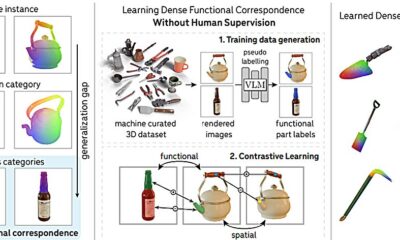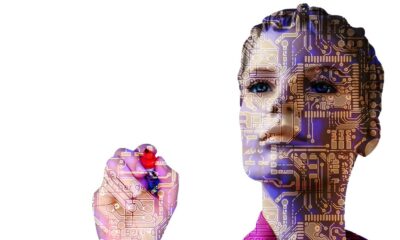Tech
How to make ‘smart city’ technologies behave ethically

As local governments adopt new technologies that automate many aspects of city services, there is an increased likelihood of tension between the ethics and expectations of citizens and the behavior of these “smart city” tools. Researchers are proposing an approach that will allow policymakers and technology developers to better align the values programmed into smart city technologies with the ethics of the people who will be interacting with them.
“Our work here lays out a blueprint for how we can both establish what an AI-driven technology’s values should be and actually program those values into the relevant AI systems,” says Veljko Dubljević, corresponding author of a paper on the work and Joseph D. Moore Distinguished Professor of Philosophy at North Carolina State University.
At issue are smart cities, a catch-all term that covers a variety of technological and administrative practices that have emerged in cities in recent decades. Examples include automated technologies that dispatch law enforcement when they detect possible gunfire, or technologies that use automated sensors to monitor pedestrian and auto traffic to control everything from street lights to traffic signals.
“These technologies can pose significant ethical questions,” says Dubljević, who is part of the Science, Technology & Society program at NC State.
“For example, if AI technology presumes it detected a gunshot and sends a SWAT team to a place of business, but the noise was actually something else, is that reasonable?” Dubljević asks. “Who decides to what extent people should be tracked or surveilled by smart city technologies? Which behaviors should mark someone out as an individual who should be under escalated surveillance?
“These are reasonable questions, and at the moment there is no agreed-upon procedure for answering them. And there is definitely not a clear procedure for how we should train AI to answer these questions.”
To address this challenge, the researchers looked to something called the Agent Deed Consequence (ADC) model. The ADC model holds that people take three things into account when making a moral judgment: the agent, which is the character or intent of the person who is doing something; the deed, or what is being done; and the consequence, or the outcome that results from the deed.
In their paper now published in Algorithms, the researchers demonstrate that the ADC model can be used to not only capture how humans make value judgments and ethical decisions, but can do so in a way that can be programmed into an AI system. This is possible because the ADC model uses deontic logic, which is a type of imperative logic.
“It allows us to capture not only what is true, but what should be done,” says Daniel Shussett, first author of the paper and a postdoctoral researcher at NC State. “This is important because it drives action, and can be used by an AI system to distinguish between legitimate and illegitimate orders or requests.”
“For example, if an AI system is tasked with managing traffic and an ambulance with flashing emergency lights approaches a traffic light, this may be a signal to the AI that the ambulance should have priority and alter traffic signals to help its travel quickly,” says Dubljević. “That would be a legitimate request. But if a random vehicle puts flashing lights on its roof in an attempt to get through traffic more quickly, that would be an illegitimate request and the AI should not give them a green light.
“With humans, it is possible to explain things in a way where people learn what should and shouldn’t be done, but that doesn’t work with computers. Instead, you have to be able to create a mathematical formula that represents the chain of reasoning. The ADC model allows us to create that formula.”
“These emerging smart city technologies are being adopted around the world, and the work we’ve done here suggests the ADC model can be used to address the full scope of ethical questions these technologies pose,” says Shussett. “The next step is to test a variety of scenarios across multiple technologies in simulations to ensure the model works in a consistent, predictable way. If it passes those tests, it would be ready for testing in real-world settings.”
More information:
Daniel Shussett et al, Applying the Agent-Deed-Consequence (ADC) Model to Smart City Ethics, Algorithms (2025). DOI: 10.3390/a18100625
Citation:
How to make ‘smart city’ technologies behave ethically (2025, October 20)
retrieved 20 October 2025
from https://techxplore.com/news/2025-10-smart-city-technologies-ethically.html
This document is subject to copyright. Apart from any fair dealing for the purpose of private study or research, no
part may be reproduced without the written permission. The content is provided for information purposes only.
Tech
Spark plasma sintering and diffusion technology yield high-performance permanent magnets for green industries

A research team has developed an innovative manufacturing process for permanent magnets that overcomes the limitations of conventional techniques. The team’s breakthrough significantly advances the diffusion technology, which is essential for improving magnetic performance, and creates new possibilities for applying high-efficiency magnets in eco-friendly industries such as electric vehicles, wind turbines, and robotics.
The findings are published in the Journal of Alloys and Compounds.
The joint research team from the Nano Technology Research Division at DGIST was led by Dr. Donghwan Kim and Dr. Jungmin Kim.
With the rapid growth of the electric vehicle and wind power sectors, the demand for powerful permanent magnets capable of stable operation at high temperatures has soared. A major example is the neodymium (Nd-Fe-B) permanent magnet, widely used in electric vehicle motors. However, these magnets experience a decline in magnetic performance under extreme heat, requiring the addition of heavy rare-earth elements such as terbium (Tb) and dysprosium (Dy) to maintain their strength. The challenge is that these elements are both rare and expensive.
To address this issue, the grain boundary diffusion process has been widely adopted. This technique enhances magnetic performance by infiltrating a small amount of heavy rare-earth material into the magnet’s surface. However, diffusion in this process is limited to the surface layer and does not penetrate into the magnet’s interior, making it difficult to apply to thick magnets.
To overcome this limitation, the research team combined spark plasma sintering, an advanced manufacturing technique, with the grain boundary diffusion process. By pre-mixing the diffusion material during the powder-based magnet fabrication stage, uniform diffusion was achieved throughout the magnet. Consequently, the diffusion depth increased markedly compared with that achieved by existing methods, allowing for the creation of a core–shell structure in which the magnet exhibits uniform and enhanced magnetic performance.
Remarkably, even with the same amount of rare-earth material, the new process achieved higher diffusion efficiency and significantly improved overall performance. This advancement makes it possible to produce magnets that are smaller and lighter while maintaining strong magnetic strength. It is expected to contribute to the miniaturization, weight reduction, and improved energy efficiency of electric vehicle motors. Additionally, the process shows great potential for application to large-scale magnets.
Principal Researcher Dr. Donghwan Kim stated, “This study presents a method that overcomes the limitations of the conventional grain boundary diffusion technology, enabling uniform performance throughout the magnet. It will make a significant contribution to the development of high-performance permanent magnets required in eco-friendly energy industries such as electric vehicles and wind power generation.”
More information:
Seong Chan Kim et al, Homogeneous core-shell structure formation in Nd-Fe-B sintered magnets through advanced spark plasma sintering and internal grain boundary diffusion, Journal of Alloys and Compounds (2025). DOI: 10.1016/j.jallcom.2025.183635
Citation:
Spark plasma sintering and diffusion technology yield high-performance permanent magnets for green industries (2025, October 20)
retrieved 20 October 2025
from https://techxplore.com/news/2025-10-plasma-sintering-diffusion-technology-yield.html
This document is subject to copyright. Apart from any fair dealing for the purpose of private study or research, no
part may be reproduced without the written permission. The content is provided for information purposes only.
Tech
Mystery Object From ‘Space’ Strikes United Airlines Flight Over Utah

The National Transportation Safety Board confirmed Sunday that it is investigating an airliner that was struck by an object in its windscreen, mid-flight, over Utah.
“NTSB gathering radar, weather, flight recorder data,” the federal agency said on the social media site X. “Windscreen being sent to NTSB laboratories for examination.”
The strike occurred Thursday, during a United Airlines flight from Denver to Los Angeles. Images shared on social media showed that one of the two large windows at the front of a 737 MAX aircraft was significantly cracked. Related images also reveal a pilot’s arm that has been cut multiple times by what appear to be small shards of glass.
Object’s Origin Not Confirmed
The captain of the flight reportedly described the object that hit the plane as “space debris.” This has not been confirmed, however.
After the impact, the aircraft safely landed at Salt Lake City International Airport after being diverted.
Images of the strike showed that an object made a forceful impact near the upper-right part of the window, showing damage to the metal frame. Because aircraft windows are multiple layers thick, with laminate in between, the window pane did not shatter completely. The aircraft was flying above 30,000 feet—likely around 36,000 feet—and the cockpit apparently maintained its cabin pressure.
So was it space debris? It is impossible to know without more data. A very few species of birds can fly above 30,000 feet. However, the world’s highest flying bird, Rüppell’s vulture, is found mainly in Africa. An unregulated weather balloon is also a possibility, although it’s not clear whether the velocity would have been high enough to cause the kind of damage observed. Hail is also a potential culprit.
Assuming this was not a Shohei Ohtani home run ball, the only other potential cause of the damage is an object from space.
That was the initial conclusion of the pilot, but a meteor is more likely than space debris. Estimates vary, but a recent study in the journal Geology found that about 17,000 meteorites strike Earth in a given year. That is at least an order of magnitude greater than the amount of human-made space debris that survives reentry through Earth’s atmosphere.
A careful analysis of the glass and metal impacted by the object should be able to reveal its origin.
This story originally appeared on Ars Technica.
Tech
WIRED Roundup: Satellites Data Leak, Cybertrucks, Politicized Federal Workers

Zoë Schiffer: Yeah, I mean, I was talking to someone before these recent layoffs who’d worked at the CDC previously and had been pretty involved in efforts to study the impact of certain diseases or pandemics specifically on pregnant populations, and this person had told me a while ago, that entire team was gone. They didn’t have many people in place anymore who could look at particularly vulnerable populations from a health perspective, which I found pretty sad and disturbing, but now, I mean, it’s just getting so much worse. It’s getting so much worse.
Jake Lahut: And Russell Vought seems to be quite happy about each additional version of this that keeps coming down the pike, so.
Zoë Schiffer: Right. Okay. We’ll talk more about these federal layoffs and how they’ve affected other agencies too in our next segment. But before we go to break, I’ve got a fun and very tech bro scoop for you, Cybertrucks.
Jake Lahut: Yeah. Honestly, I should be paying you to be on the show today, Zoë, so tell me more about it.
Zoë Schiffer: Okay. Well, I found this story so charming because essentially our Features Director Reyhan had said, “Let’s do a photo essay of Cybertruck owners.” And I was like, ‘I volunteer as tribute. I really want to do this.” So I contacted a bunch of people, I was actually going around, and when I saw Cybertrucks, I would leave little notes on their car. Not a single person ever responded to me, I was like.
Jake Lahut: Stalker behavior.
Zoë Schiffer: “Okay, all right.” But eventually I got in contact with this guy who runs Cybertrucks Owners Only, which is this 50,000 person Facebook group that’s really, really active. And he, while very suspicious of the media, like many Cybertrucks owners was like, “I’m game. If you come to Palm Springs on this weekend, we can have a Cybertrucks meetup and you can go meet people, you can take photos and interview them.” I love reporting where your original thesis is completely disproven in the course of the reporting, and the Cybertrucks owners really see themselves as the victims of this campaign. They’re being spit at, they’re being targeted, people yell that they’re Nazis. And to a lot of people who I talk to, they don’t see their purchase of this car as at all political. They’re like, “I just like the car. It’s a cool car, it’s fun and all of these crazy liberal people are screaming at me all day. I have my kids in the car and they’re chasing after me calling me a Nazi.” The article came out today, there’s some really cool photos. I’m curious to hear what you thought.
-

 Tech1 week ago
Tech1 week agoAustralian airline Qantas says millions of customers’ data leaked online
-

 Tech1 week ago
Tech1 week agoUK police to upgrade illicit asset recovery system | Computer Weekly
-

 Tech4 days ago
Tech4 days agoWhy the F5 Hack Created an ‘Imminent Threat’ for Thousands of Networks
-

 Entertainment1 week ago
Entertainment1 week agoKaty Perry and Justin Trudeau are dating: Report
-

 Tech5 days ago
Tech5 days agoWhat Is Google One, and Should You Subscribe?
-

 Entertainment1 week ago
Entertainment1 week agoVictoria Beckham thinks Brooklyn Beckham is fed up with Nicola Peltz drama?
-

 Business1 week ago
Business1 week agoEnvironment minister Bhupender Yadav heads to Brazil: India engages in pre-talks ahead of COP30; climate finance and adaptation on agenda – The Times of India
-

 Politics1 week ago
Politics1 week agoNo survivors likely after Tennessee military blast, say officials

















